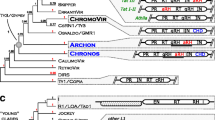Summary
We have used the polymerase chain reaction to analyse Ty1-copia group retrotransposons of flowering plants. All eight species studied contain reverse transcriptase fragments from Tyl-copia group retrotransposons. Sequence analysis of 31 subcloned fragments from potato reveals that each is different from the others, with predicted amino acid diversities between individual fragments varying between 5% and 75%. Such sequence heterogeneity within a single species contrasts strongly with the limited diversity seen in such retrotransposons in yeast and Drosophila. The fragments from the other seven plant species examined are also heterogeneous, both within and between species, showing that this is a general property of this transposon group in plants. Phylogenetic analysis of all these sequences reveals that many of them fall into subgroups which span species boundaries, such that the closest homologue of one sequence is often from a different species. We suggest that both vertical transmission of Ty1-copia group retrotransposons within plant lineages and horizontal transmission between different species have played roles in the evolution of Ty1-copia group retrotransposons in flowering plants.
Similar content being viewed by others

References
Bingham PM, Zachar Z (1989) Retrotransposons and the FB element from Drosophila melanogaster. In: Berg DE, Howe MM (eds) Mobile DNA. American Society for Microbiology, Washington DC, pp 485–502
Boeke J (1989) Transposable elements in Saccharomyces cerevisiae. In: Berg DE, Howe MM (eds) Mobile DNA. American Society for Microbiology, Washington DC, pp 335–374
Camirand A, Brisson N (1990) The complete nucleotide sequence of the Tst1 retrotransposon of potato. Nucleic Acids Res 18:4929
Charlesworth B (1986) Genetic divergence between transposable elements. Genet Res 48:111–118
Devereux J, Haeberli P, Smithies O (1984) A comprehensive set of sequence analysis programs for the VAX. Nucleic Acids Res 12:387–395
Doolittle RF, Feng DF, Johnson MS, McClure MA (1989) Origins and evolutionary relationships of retroviruses. Quart Rev Biol 64:1–29
Doolittle RF, Feng DF (1990) Nearest neighbour procedure for relating progressively aligned amino acid sequences. Meth Enzymol 183:659–669
Emori Y, Shiba T, Kanaya S, Inouye S, Yuki S, Saigo K (1985) Determination of the nucleotide sequences of copia and copia-related RNA in Drosophila VLP. Nature 315:773–776
Feng DF, Doolittle RF (1987) Progressive sequence alignment as a prerequisite to correct phylogenetic trees. J Mol Evol 25:351–360
Feng DF, Doolittle RF (1990) Progressive alignment and phylogenetic tree construction of protein sequences. Meth in Enzymol 183:375–387
Flavell AJ, Levis R, Simon MA, Rubin GM (1981) The 5′ termini of RNAs encoded by the transposable element copia. Nucleic Acids Res 9:6279–6291
Garfinkel DJ, Bocke JD, Fink GR (1985) Ty element transposition: Reverse transcriptase and virus-like particles. Cell 42:507–517
Grandbastien M-A, Spielmann A, Caboche M (1989) Tnt1, a mobile retroviral-like transposable element of tobacco isolated by plant cell genetics. Nature 337:376–380.
Gyllensten U (1989) Direct sequencing of in vitro amplified DNA. In: Erlich HA (ed) PCR Technology. Stockton Press, New York, p 54
Higgins DG, Sharp PM (1988) CLUSTAL: A package for performing multiple sequence alignments on a microcomputer. Gene 73:237–244
Konieczny A, Voytas DF, Ausubel FM (1990) Retrotransposable elements in Arabidopsis thaliana. In: Plant Gene Transfer. Alan R. Liss. pp 65–70
Konieczny A, Voytas DF, Cummings MP, Ausubel FM (1991) A superfamily of Arabidopsis thaliana retrotransposons. Genetics 127:801–809
Kuff EL, Lueders KK (1988) The intracisternal A-particle gene family: structural and functional aspects. Adv Cancer Res 51:183–276
Mignery CA, Pikaard CS, Park WD (1988) Molecular characterization of the patatin multigene family of potato. Gene 62:27–44
Miller DW, Miller LK (1982) A virus mutant with the insertion of a copia-like transposable element. Nature 299:562–564
Mount SM, Rubin GM (1985) Complete nucleotide sequence of the Drosophila tranposable element copia: Homology between copia and retroviral proteins. Mol Cell Biol 5:1630–1638
Potter SS, Brorein WJ, Dunsmuir P, Rubin GM (1979) Transposition of elements of the 412, copia and 297 dispersed repeated gene families in Drosophila. Cell 17:415–427
Rothnie HM, McCurrach KJ, Glover LA, Hardman N (1991) Retrotransposon-like nature of Tp1 elements: implications for the organization of highly repetitive, hypermethylated DNA in the genome of Physarum polycephalum. Nucleic Acids Res 19:279–286
Saghai-Marzoof MA, Soliman KM, Jorgennsen RA, Allard RW (1984) Ribosomal DNA spacer length polymorphism in barley. Mendelian inheritance, chromosomal location and population dynamics. Proc Natl Acad Sci USA 81:8014–8018
Shih A, Misra R, Rush MG (1989) Detection of multiple novel reverse transcriptase coding sequences in human nucleic acids: Relation to primate retroviruses. J Virol 63:64–75
Temin HM (1980) Origin of retroviruses from cellular moveable genetic elements. Cell 21:599–600
Varmus HE, Brown P (1989) Retroviruses. In: Berg DE, Howe MM (eds) Mobile DNA. American Society for Microbiology, Washington DC; pp 53–108
Voytas DF, Ausubel FM (1988) A copia-like transposable element family in Arabidopsis thaliana. Nature 336:242–244
Walbot V, Cullis CA (1985) Rapid genomic change in higher plants. Annu Rev Plant Physiol 36:367–396
Wolfe KKH, Gouy M, Yang Y-W, Sharp PM, Li W-H (1989) Date of the monocot-dicot divergence estimated from chloroplast DNA sequence data. Proc Natl Acad Sci USA 86:6201–6201
Xiong Y, Eickbush TH (1990) Origin and evolution of retroelements based upon their reverse transcriptase sequences. EMBO J 9:3353–3362
Yuki SS, Ishimaru S, Inouye S, Saigo K (1986) Identification of genes for reverse transcriptase-like enzymes in two Drosophila retrotransposons, 412 and gypsy; a rapid detection method of reverse transcriptase genes using YXDD box probes. Nucleic Acids Res 14:3017–3030
Author information
Authors and Affiliations
Additional information
Communicated by J. Finnegan
Rights and permissions
About this article
Cite this article
Flavell, A.J., Smith, D.B. & Kumar, A. Extreme heterogeneity of Ty1-copia group retrotransposons in plants. Molec. Gen. Genet. 231, 233–242 (1992). https://doi.org/10.1007/BF00279796
Issue Date:
DOI: https://doi.org/10.1007/BF00279796



